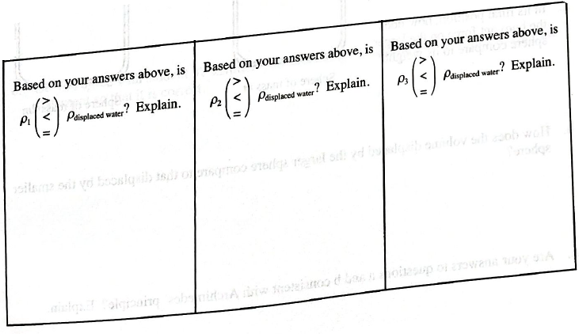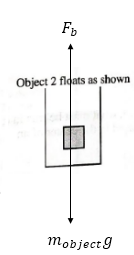
Concept explainers
1. Three objects are at rest in three beakers of water as shown.
- Compare the mass, volume, and density of the objects to the mass, volume, and density of the displaced water. Explain your reasoning in each case.


The comparison of mass, volume and density of the object with the displaced water.
Explanation of Solution
Given:
Three objects are at rest in three beakers of water as shown:
FormulaUsed:
Use Archimedes principle which is expressed as follows:
Here, the buoyant force is
Calculation:
For Object 1
Free body diagram of the 1st object is shown below:
As the object floats on the top of the surface, the displaced volume must be less than the volume of the object. Thus,

As the body is floating on the top surface, then the weight of the body is equal to the buoyant force. Thus, for equilibrium,
Thus, the mass of the object is equal to the mass of the displaced water.
For density, apply summation of force in the vertical direction as follows:
As the
For Object 2, Free body diagram of the 2nd object is shown below:

As the object floats inside the water, the displaced volume must be equal to the volume of the object. Thus,
As the body is floating inside the water then the weight of the body is equal to the buoyant force. Thus, for equilibrium,
Thus, the mass of the object is equal to the mass of the displaced water.
For density apply summation of force in the vertical direction as follows:
Thus, the density of the object must be equal to the density of water.
For Object 3,
Free body diagram of the 3rd object is shown below:

The displaced volume must be equal to the volume of the object as it is kept inside the tank completely. Thus,
As the body is not floating inside the water, then the weight of the body is more than the buoyant force. Thus, for equilibrium,
Thus, the mass of the object is more than the mass of the displaced water.
For density, apply summation of force in the vertical direction as follows:
Thus, the density of object must be more thanthe density of water.
Conclusion:
For object 1,
For object 2,
For object 3,
Want to see more full solutions like this?
Chapter 26 Solutions
Tutorials in Introductory Physics
Additional Science Textbook Solutions
College Physics: A Strategic Approach (3rd Edition)
University Physics Volume 2
Modern Physics
Physics for Scientists and Engineers with Modern Physics
Physics for Scientists and Engineers: A Strategic Approach with Modern Physics (4th Edition)
Applied Physics (11th Edition)
- Many figures in the text show streamlines. Explain why fluid velocity is greatest where streamlines are closest together. (Hint: Consider the relationship between fluid velocity and the cross-sectional area through which it flows.)arrow_forwardA certain man has a mass of 80 kg and a density of 955 kg/m3 (excluding the air in his lungs). (a) Calculate his volume. (b) Find the buoyant force air exerts on him. (c) What is the ratio of the buoyant force to his weight?arrow_forwardFigure 11.35(a) shows the effect of tube radius on the height to which capillary action can raise a fluid. (a) Calculate the height h for water in a glass tube with a radius of 0.900 cm—a rather large tube like the one on the left. (b) What is the radius of the glass tube on the right if it raises water to 4.00 cm?arrow_forward
- An iron block of volume 0.20 m5 is suspended from a spring scale and immersed in a flask of water. Then the iron block is removed, and an aluminum block of the same volume replaces it. (a) In which case is the buoyant force the greatest, for the iron block or the aluminum block? (b) In which case does the spring scale read the largest value? (c) Use the known densities of these materials to calculate the quantities requested in parts (a) and (b). Are your calculations consistent with your previous answers to parts (a) and (b)?arrow_forwardA solid iron sphere and a solid lead sphere of the same size are each suspended by strings and are submerged in a tank of water. (Note that the density of lead is greater than that of iron.) Which of the following statements are valid? (Choose all correct statements.) (a) The buoyant force on each is the same. (b) The buoyant force on the lead sphere is greater than the buoyant force on the iron sphere because lead has the greater density. (c) The tension in the siring supporting the lead sphere is greater than the tension in the string supporting the iron sphere. (d) The buoyant force on the iron sphere is greater than the buoyant force on the lead sphere because lead displaces more water. (e) None of those statements is true.arrow_forwardWater emerges straight down from a faucet with a 1.80-cm diameter at a speed of 0.500 m/s. (Because of the construction of the faucet, there is no variation in speed across the stream.) (a) What is the flow rate in cm3/s? (b) What is the diameter of the stream 0.200 m below the faucet? Neglect any effects due to surface tension.arrow_forward
- . A box-shaped piece of concrete measures 3 ft by 2 ft by 0.5 ft (a) What is its weight? (b) Find the buoyant force that acts on it when it is submerged in water. (c) What is the net force on the concrete piece when it is underwater?arrow_forwardArchimedes' principle can be used to calculate the density of a fluid as well as that of a solid. Suppose a chunk of iron with a mass of 390.0 g in air is found to have an apparent mass of 350.5 g when completely submerged in an unknown liquid. (a) What mass of fluid does the iron displace? (b) What is the volume of iron, using its density as given in Table 11.1 (c) Calculate the fluid's density and identify it.arrow_forwardThe dolphin tank at an amusement park is rectangular in shape with a length of 40.0 m, a width of 15.0 m, and a depth of 7.50 m. The tank is filled to the brim to provide maximum splash during dolphin shows. What is the total amount of force exerted by the water on a. the bottom of the tank, b. the longer wall of the tank, and c. the shorter wall of the tank?arrow_forward
- Gauge pressure in the fluid surrounding an infant's brain may rise as high as 85.0 mm Hg (5 to 12 mm Hg is normal), creating an outward force large enough to make the skull grow abnormally large. (a) Calculate this outward force in newtons on each side of an infant's skull if the effective area of each side is 70.0 cm2. (b) What is the net force acting on the skull?arrow_forwardTwo thin-walled drinking glasses having equal base areas bin different shapes, with very different cross-sectional areas above the base, are filled to the same level with water. According to the expression P = P0 + gh, the pressure is the same at the bottom of both glasses. In view of this equality, why does one weigh more than the other?arrow_forward(a) Verify that a 19.0% decrease in laminar flow through a tube is caused by a 5.00% decrease in radius, assuming that all other factors remain constant, as stated in the text. (b) What increase in flow is obtained from a 5.00% increase in radius, again assuming all other factors remain constant?arrow_forward
 College PhysicsPhysicsISBN:9781938168000Author:Paul Peter Urone, Roger HinrichsPublisher:OpenStax College
College PhysicsPhysicsISBN:9781938168000Author:Paul Peter Urone, Roger HinrichsPublisher:OpenStax College College PhysicsPhysicsISBN:9781305952300Author:Raymond A. Serway, Chris VuillePublisher:Cengage Learning
College PhysicsPhysicsISBN:9781305952300Author:Raymond A. Serway, Chris VuillePublisher:Cengage Learning
 College PhysicsPhysicsISBN:9781285737027Author:Raymond A. Serway, Chris VuillePublisher:Cengage Learning
College PhysicsPhysicsISBN:9781285737027Author:Raymond A. Serway, Chris VuillePublisher:Cengage Learning Physics for Scientists and Engineers, Technology ...PhysicsISBN:9781305116399Author:Raymond A. Serway, John W. JewettPublisher:Cengage Learning
Physics for Scientists and Engineers, Technology ...PhysicsISBN:9781305116399Author:Raymond A. Serway, John W. JewettPublisher:Cengage Learning Physics for Scientists and Engineers: Foundations...PhysicsISBN:9781133939146Author:Katz, Debora M.Publisher:Cengage Learning
Physics for Scientists and Engineers: Foundations...PhysicsISBN:9781133939146Author:Katz, Debora M.Publisher:Cengage Learning





